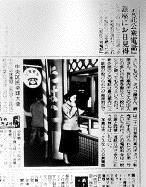
|
||

|
The loss of telephones destroyed in World War II leads to a serious shortage of telephones. One of several measures to alleviate the shortage is the 'consignment' of telephones from the telephone company to store fronts and other locations which will monitor their use as public telephones. The consignees do not function as subscribers, but as a sort of extension of the facilities of the local exchange. Combined with the new simplified public telephones, the convenience of these facilities leads to a gradual increase in numbers. By Showa 28 (1953) the design of these phones changes to a conspicuous red color, and thus begins the familiar public 'red phone' of Japan's street scene. Around the same time, the real-time telephone response replaces the postcard in the popular listener-participation Radio Quiz show. | |

|
||